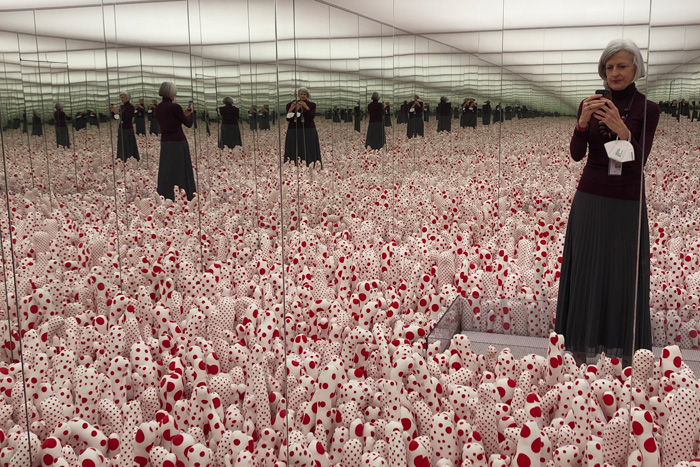Graduate Story: Anne Helmreich ’85, Smithsonian Archives of American Art

Anne Helmreich, seen here in the midst of a Yayoi Kusama installation at the Smithsonian's Hirshhorn Museum in Washington, D.C.
“If I had to pinpoint transformational experiences, high on my list would be my junior year abroad in Vienna—Dickinson’s deep commitment to study abroad fueled my interest in studying overseas.”
—Anne Helmreich ’85
At the end of 2022, Anne Helmreich ’85 was named director of the Smithsonian’s Archives of American Art, bringing with her 35 years of experience in higher education and arts administration. The former history major was previously both a senior program officer and an associate director with the Getty Foundation and dean of the College of Fine Arts at TCU.
Tell us about your career.
My career has been primarily in the arts and learning, approaching this combination from different pathways. I earned a Ph.D. in art history and became very interested in the productive intersections between academic art history and art museum practice and took up teaching positions first at Texas Christian University and then at Case Western Reserve University (CWRU). While at CWRU, I became director of the Baker-Nord Center for the Humanities, which fueled my interest in interdisciplinary work and, more specifically, the digital humanities. Now, I have a new opportunity to support students, scholars and the public interested in the arts as the director of Archives of American Art. We are a research center dedicated to collecting, preserving and making accessible materials relating to the history of the visual arts in the United States. In short, we are American’s storytellers for the arts.
What was your Dickinson experience like?
Looking back, I realize how eclectic it might seem, but it all fit together! I was a history major with an art history minor, and I also played flute in the orchestra, second row in the women’s rugby team and was a member of Kappa Alpha Theta sorority. I loved moving between these interests and activities and the different friends I had because of them.
How did Dickinson help prepare you for where you are today?
This could be a very long list! As a liberal-arts college, Dickinson taught me to think critically and strategically and communicate clearly. Also high on my list would be my internship at the U.S. Army War College and projects in the Trout Gallery because, like my study-abroad experience, they taught me that history can be found in objects and buildings and the power of bringing these stories to light. In interviewing for my most recent job, I shared with the committee the sense of curiosity sparked in my history methods class when we worked with primary source documents, and I hope to recreate this journey of discovery for others. And, of course, my art history classes cultivated a life-long passion for the arts, and I was so pleased, many years later, when my former art history professor, Professor of Fine Arts Sharon Latchaw Hirsh (now president of Rosemont College), asked me to contribute a chapter to a book she was editing. I loved giving back to the person who helped me get to where I am today.
TAKE THE NEXT STEPS
Published June 7, 2023